
According to BEAR Scotland, the consortium of private companies who manage trunk roads on behalf of Transport Scotland, around 160mm of rain fell in 36 hours around the Rest and Be Thankful two weekends ago and caused eleven landslips (see here– news release dated 11th October):
- “One small landslide at the Rest and be Thankful. Debris reached the road and was cleared.
- Two further landslides at the Rest and be Thankful. Debris was captured in the debris net and debris pit.
- Four landslides at Glen Kinglas. Debris reached the road and has been cleared.
- Two small landslides at Glen Kinglas which were captured in the debris bund.
- Two very substantial landslides on the A83 at the A815 Dunoon junction. The debris which reached the road has been cleared.”
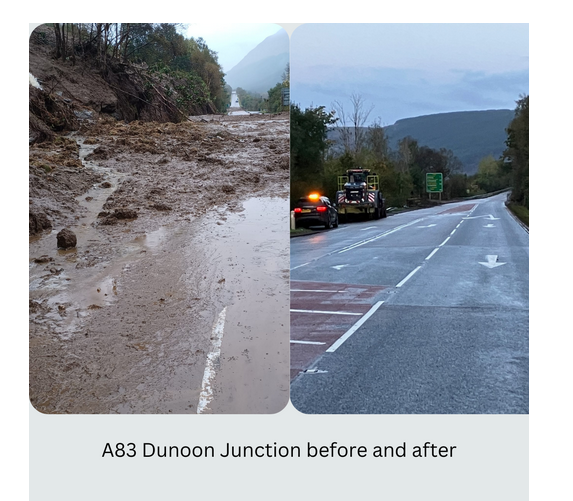
The rainfall figure appears to have been taken from the two SEPA rain guages at the Rest and Be Thankful just above Glen Kinglas. It is likely to be reasonably accurate for the area most affected by the landslips. 160mm in 36 hours is significantly less than the 200mm reported in Cowal (see here) and, as I argued in my last post (see here), it is clear now government should be preparing for extreme rain events of that magnitude and more.
Eight of the eleven landslips took place on the steep south facing slopes in Glen Kinglas below Binnein an Fhidhleir. These slopes are up to almost 800m in height and catch a significant among of rainfall which then drains quickly downhill (helped by the landforms below the ridge which are hard to see from the road below). Being south facing, this land has been favoured for farming, not forestry, as on the opposite side of the glen
These eight landslips also took place within a single landholding, the Strone Estate.
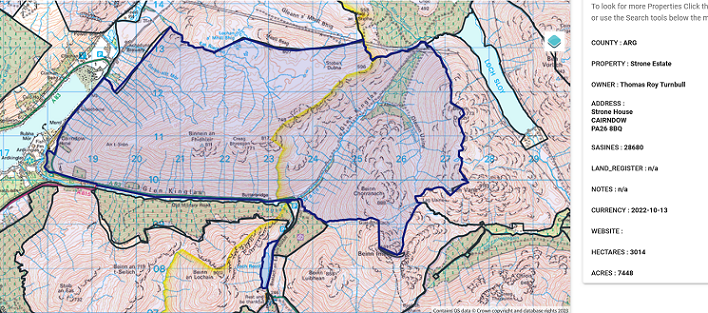
Tom Turnbull, who owns and manages the estate, is also chair (see here) of the Association of Deer Management Groups, the umbrella organisation for the bodies that were set up to control deer numbers in Scotland on a voluntary basis.
A history of the landslips above the A83 around Glen Kinglas and government’s response
In August 2004 an extreme rain event triggered landslips which blocked roads across Scotland, including the A83 near Cairndow and Glen Kinglas:
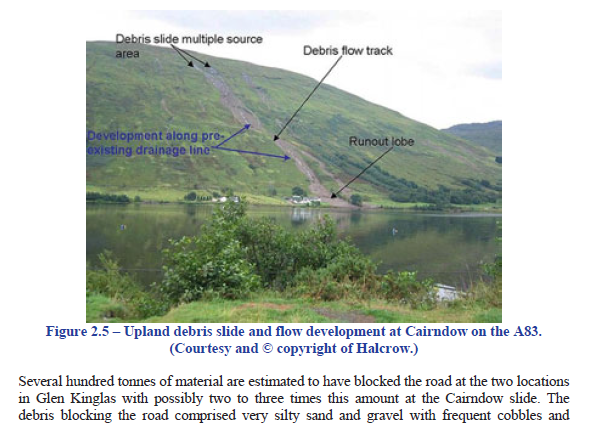
The Cairndow and Glen Kinglas landslips in 2004 also originated on the Strone Estate but some flowed over its boundary to damage both public infrastructure and private property:
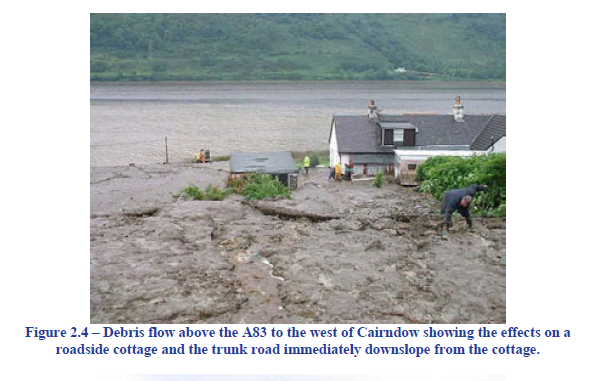 In response to this landslip disaster the Scottish Government of the time set up the Scottish Road Network Landslide Study. This was tasked with looking into the causes of the landslips and what might be done to protect the transport network in future. It reported four years later in October 2008 (see here).
In response to this landslip disaster the Scottish Government of the time set up the Scottish Road Network Landslide Study. This was tasked with looking into the causes of the landslips and what might be done to protect the transport network in future. It reported four years later in October 2008 (see here).
The Report, 268 pages with appendices, included detailed and very helpful descriptions of the various landslips that had occurred in 2004 (hence the photos above), information on other landslips that had affected the road network, data on rainfall, consideration of what type of slopes were most at risk and short case studies of landslides abroad. From all this data and analysis it produced a map of the roads most at risk from landslips in Scotland:
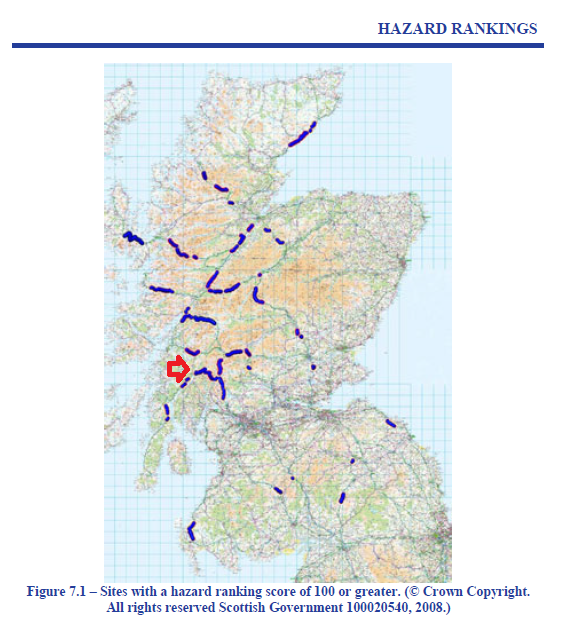
While the report was trail-blazing in many ways it had three major limitations:
- it was focused on roads and did not look at landslip risk to other infrastructure such as railways, powerlines or housing (all of which have been severely damaged by landslips in the last five years;
- its consideration of how vegetation, including woodland, impacts on landslips was extremely limited; and
- the three main solutions proposed to mitigate landslip risk to the road network were all engineering based (debris flow prevention such as nets, road protection such as shelters and road re-alignment)
These limitations might not have mattered if the research programme the report recommended had been progressed. However, the 2008 financial crash and the imposition of austerity by the UK Government put more emphasis than ever before on government agencies prioritising problems and only addressing those deemed most urgent: in the case of Transport Scotland is has been digging holes for itself under Beinn Luibhean at the Rest and Be Thankful ever since.
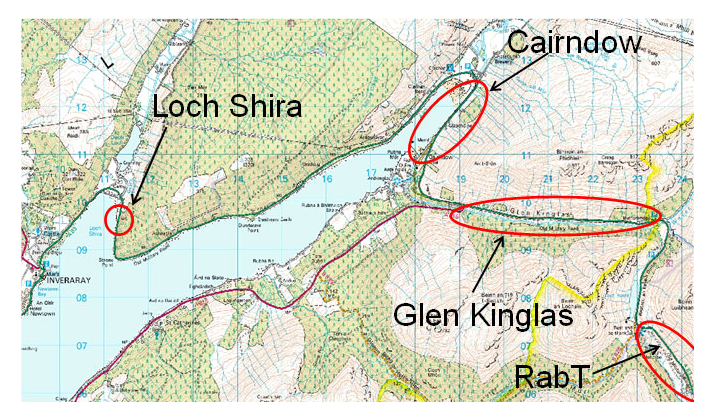
The Road Network Landslide Study had identified three areas on the A83, apart from the Rest and Be Thankful, as being being at risk and five years later, in 2013, Transport Scotland finally commissioned BEAR to look at these sites in more detail (see here). BEAR came up with a number of recommendations for Glen Kinglas:

The assessment shows the blinkered focus of the transport industry on engineering solutions: it should not have been a choice between either engineering or forestry planting (land-use).
It took another five years before the announcement (see here) that bunds were to be constructed in Glen Kinglas out of material excavated from the Rest and Be Thankful.
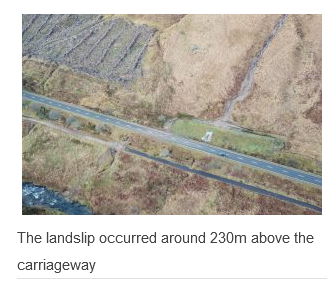
The first was constructed not a moment too soon. In December 2019 the first bund was reported (see here) to have stopped a landslip hitting the A83 (left). In September 2022, however, it was reported (see here) that work on a further bund in Glen Kinglas had been very slow due to a shortfall in material from the Rest and Be Thankful work.
These bunds caught two of the eight landslips in Glen Kinglas but the other six reached the road. The problem with relying on engineering solutions alone is not just the cost but that as extreme rainfall events increase Transport Scotland is always likely to be playing catch-up. The narrow focus is illustrated by the fact that BEAR Scotland did not mention this landslip at Cairndow in their news release, presumably because it did not reach the road:

BEAR’s detailed site visits in 2013 had concluded that “the Cairndow study area is the lowest risk of the three highlighted landslide areas”. Ten years later this landslips shows it is another disaster waiting to happen!
Forestry and woodland in Glen Kinglas

While this landslip has uprooted some trees, others on the right of the affected area have been left standing and have helped stem the debris flow. Meantime the trees in the centre may have helped keep that part of the slope intact.
As I argued in my last post (see here), while planting of trees is not a panacea for landslips, if done with care it potentially offers a cheap and effective solution. Had some trees been planted on these slopes immediately after the events of 2004 that might just have prevented some of those six landslips or stopped them reaching the road.

Instead of planting trees above the A83, however, the Strone Estate has been given permission on several occasions to fell the small plantations alongside it. The Argyll and Bute planning portal shows the then Forestry Commission granted the Strone Estate permission to fell three plantations after 2004, in 2006 and 2008 (one of which you can see in the photo below):
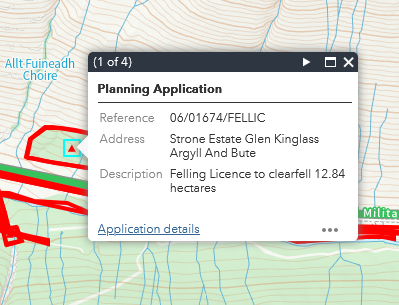
While the Road Network Landslide Study did not say much about trees, it was emphatic about one point, clearfelling is not good for slope stability:
“recs5. Although, the practice of clear-felling is not as widespread as it once was in Scotland [sadly that trend has subsequently reversed], forestry practices can have a significant impact on the stability of hillsides. Learning from international best practice, particularly that from British Columbia in Canada, in terms of forestry harvesting to maintain hillside stability should be seen as a priority; this will require dialogue with the Forestry Commission”
While the Landslide Report was published too late to affect the original felling permissions, felling was then delayed and the Scottish Forestry Map viewer shows that clearfelling licenses were issued to two of those plantations in 2017 and 2021.
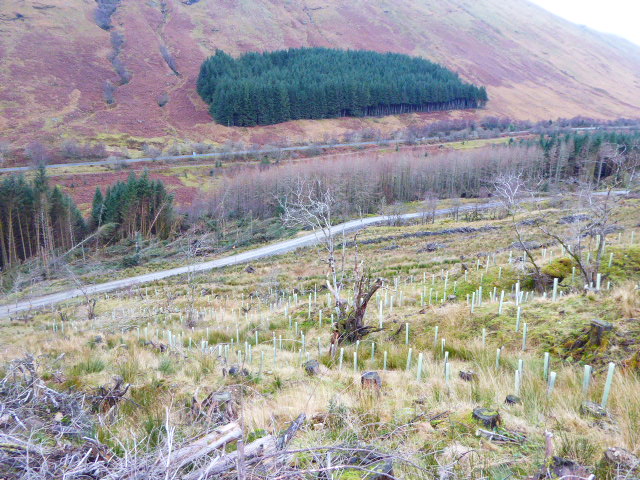
Scottish Forestry, therefore, appear to have paid absolutely no attention to the recommendations of the Roads Network Landslide study. On the south side of Glen Kinglas, although not threatening any road, a large section of forest has also recently been clear-felled:
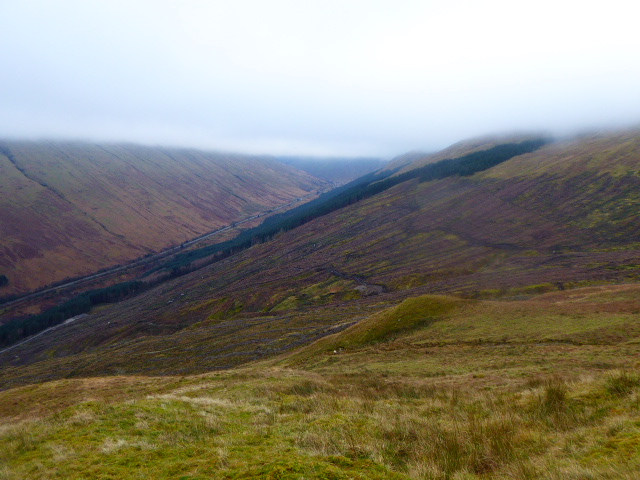
Given the instability of the slope above the A83 in Kinglas was well-known, the sensible thing would have been for Scottish Forestry to refuse the felling licenses on the north side of the glen. Scandalously, even though this would be in the public interest, it appears to have no means of compensating landowners for loss of anticipated income in cases such as this. Another failure of the Forest Grants Scheme.
Land-use and land management on the Strone Estate – deer
On 9th March 2023 Tom Turnbull, the owner of the Strone Estate wrote an article for the Scotsman in his capacity of chair of the ADMGs entitled “We need to challenge the assumption that less deer will mean more trees (see here)“.
Whose assumption? A significant proportion of Highland Scotland is now peatbog and generally too wet for trees to grow. Moreover, the evidence now shows that natural regeneration of woodland only takes off when deer are reduced to about two per square kilometre, significantly below NatureScot’s current targets. Above this, density tree regeneration is slow to non-existent. Reducing deer from 10 per km to 6 per km, for example, won’t result in much appreciable difference.
The Inverary and Tyndrum Deer Management Group, which includes the Strone Estate, updated their background information and plan for 2015-25 in October 2022 (see here). In 2022 3084 deer were counted over 46,895ha, an average of 6.58 deer per kilometre (NatureScot counted 7.3 in a helicopter account in 2017). These figures are likely to a significant underestimate as deer are very hard to count in open country on foot and even more difficult to count when in woodland/forest. While most members of the DMG apparently conduct deer counts on foot each Spring there is no breakdown of numbers by estate so information about the deer population on the Strone Estate and whether it is lower or higher than the stated average is not known.
While there is a section on the public interest in the Deer Management Plan, this does not mention the relationship between grazing levels and landslips or provideany information about the number of deer that may be grazing the hillsides above the A83. Deer browsing not only prevents woodland regeneration, it also reduces the height of other vegetation increasing the rate water runs off the hill and with that the likelihood of landslips. In a saner world we would know how many deer are grazing the flanks of Glen Kinglas and act on that information.
Land-use and land-management on the Strone Estate – livestock
Contrary to what Mr Turnbull was claiming in the Scotsman, there is good evidence from his own estate of how grazing impacts on native woodland. There are several blocks of planted native woodland in the upper part of Glen Kinglas (which lies within the Loch Lomond and Trossachs National Park boundary) which, when I last visited in March, were clearly being destroyed by livestock grazing before any account is taken of deer (the ITDMG plan says the objective of the Strone Estate is both deer stalking and farming):
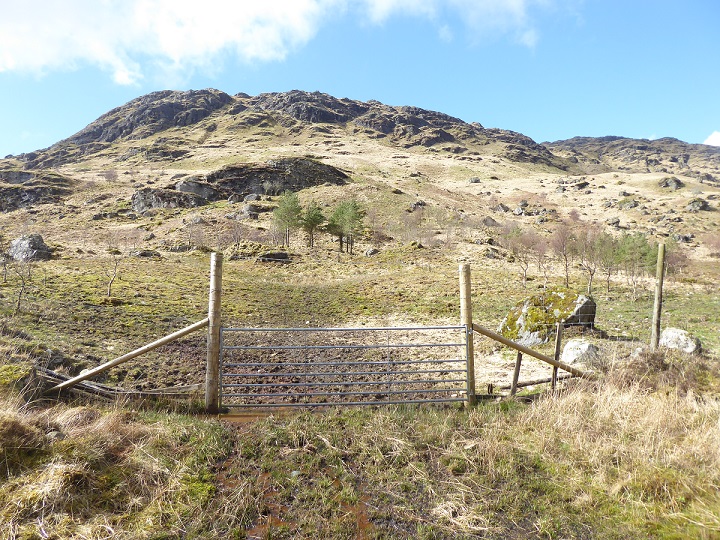
The area within this enclosure was marked green, low herbivore pressure, in the Strone Estate Habitat Impact Assessment (see below). In fact, the lack of any further tree regeneration within the enclosure and the absence of an understorey in this part of the Butterbridge plantation since the trees were planted shows grazing pressure has been high.
That has clearly been deliberate. One possible explanation for this is Mr Turnbull has decided, as described in his Scotsman article, to introduce cattle to break up purple moor grass (molinia) to help the new plantation start to regenerate naturally. If there was a need for that, however, cattle should have been introduced BEFORE the planting, not afterwards.
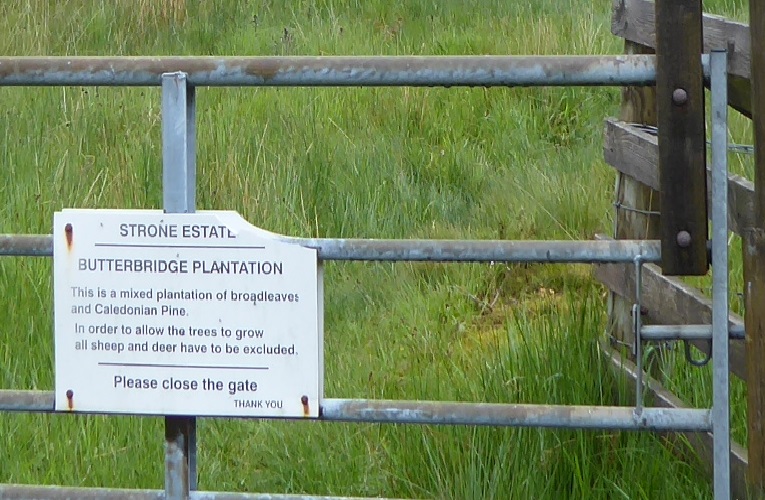
It is clear the Strone Estate’s original intention was to keep grazing animals out of the Butterbridge Plantation to enable the trees to get establlshed.
Once established, however, native woodland plantations are often deliberately opened up by landowners to provide food and/or shelter for grazing animals especially in the winter months. The straw in the top photo shows there was not enough food for the cattle here in March. As a consequence, they will have been eating the trees as well as churning up the ground.
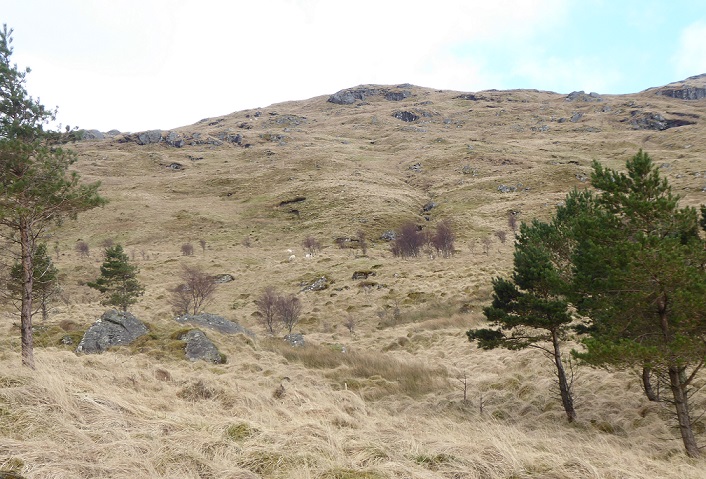
“simply reducing herbivore numbers, including sheep, to very low levels (or excluding them from an area) cannot guarantee woodland regeneration” (Tom Turnbull).
The destructive impact of grazing on the planted native woodland at the top of Glen Kinglas is both obvious on the ground and documented. Appendix 5 to Deer Management Plan is a map showing the Herbivore Impact Assessments conducted by some estates on native woodland (see here). It classifies the area pictured above as suffering high herbivore pressure (yellow). Tom Turnbull should know from his own estate that even where deer numbers are being reduced it will make no difference to woodland if grazing by livestock replaces this or is allowed to continue. Strangely, he made no mention of this in his Scotsman article or of how Scotland’s rural payments scheme subsidises landowners to keep the livestock which is helping to destroy woodland.
Earlier this year the Scottish Government provided this information about the Strone Estate:

To qualify for the Basic Payment Scheme, the largest recurring element of these payments, and the LFASS, landowners need to show they are farming the land – which in Strone’s case means keeping livestock. On top of this Strone has received a significant “greening” payment which, for non-cultivated areas, is paid for “permanent grassland”. Then there is the much smaller grant for supporting cattle through the SSBSS.
All these rural payments are designed to maintain grazing. While it is not clear if they cover the land where the landslips have occurred, they are clearly helping to destroy the native woodland plantations in upper Glen Kinglas.
While it does not appear the Scottish Forestry has funded these native woodland plantations, other agencies and bodies have. The ITDMG Plan helpfully records:
- Strone Estate received funding for 70 ha of native tree planting and deer fencing in 2014 (this looks like the £198,315 paid by the Rural Priorities scheme in 2014).
- Strone Estate also received funding for riparian tree planting from Loch Lomond & Trossachs National Park (how much?).
- Strone Estate plans to plant blocks of trees along the River Kinglas to improve migratory fish habitat, using funding from the Woodland Trust
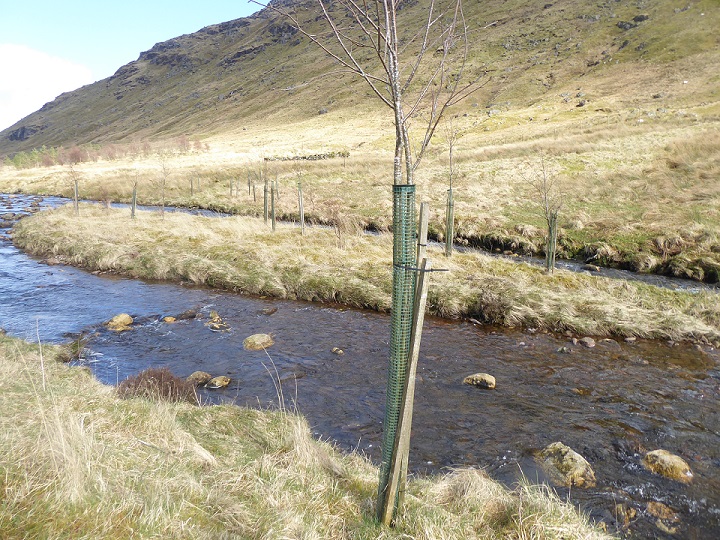
In upper Glen Kinglas one hand of government, aided by the voluntary sector, is dishing out money to Strone estate to plant trees, while the other is dishing out money to the estate to keep livestock and maintain grassland. These objectives are contradictory and in terms of the public interest completely crazy.
From a landowner perspective, however, none of this really matters as long as the gravy train continues. A National Park Authority worth its name would have spoken out publicly about what is happening and called for reform – instead they too have funded the Strone Estate.
All this public money – and even that of the Woodland Trust – could have been far better spent. Strone estate has received over c£700k between 2014 and 2022 which could have been used to end all livestock grazing on the slopes of Glen Kinglas, reduce deer numbers to two per square kilometre and plant some trees to help stabilise the slopes. Spending £700k for that purpose might not at present guarantee a reduction in the harm landslips are causing to the rural economy in places like Glen Kinglas but unless government tries we will never know.
The elephant in the room
This story of failure illustrates just how incapable our public authorities appear to be at present of seeing the big picture and the public interest:
- Transport Scotland won’t say that we need to change land-use around the road network if we are to reduce its increasing vulnerability to landslips
- The rural payments division of the Scottish Government continues to churn out money to landowners to support livestock grazing with no consideration of the consequences;
- NatureScot prompts and supports landowners to churn out deer management plans which ignore the landslip issue;
- Scottish Forestry carries on issuing felling licenses regardless;
- The LLTNPA is incapable of raising its eyes over its boundary but, as importantly, has nothing to offer having never considered the landslip problem, not even at the Rest and Be Thankful.
The question this begs is why and how has this been allowed to continue for almost 20 years? Austerity certainly hasn’t helped, it has turned public authorities inward looking and fearful of saying anything that could have budgetary implications. Nor has the convention that Public Authorities should not criticise each other, which has helped conceal how government in Scotland has been falling apart.
But underneath all this is a much bigger issue, landownership and the power of landowners. Whatever the public authority, whatever the Minister responsible, none have been prepared to criticise the way the Strone estate has been managed. And none have dared suggest that all the public money being passed its way could be much better spent. Funny that!
Mr Turnbull is now in a particularly powerful position as chair of the ADMGn one of the primary bodies who have been responsible for stopping all meaningful attempts to control deer numbers in Scotland. All the more reason that the Scottish Government should challenge him about the way his own land in Glen Kinglas has been managed and require this to change. And, should he fail to co-operate, what better place for the Scottish Government to use their compulsory purchase powers in the public interest?
Acknowledgement
I would like to acknowledge the help I have received in researching and producing this piece from various people who would prefer/require to remain anonymous.

That is a great piece of research Nick .and I despair of our lack of an integrated approach to landuse in Scotland. Way back in 1982 Adam Watson and I were invited on a study tour of the Swiss Alps. The report, Tourism, Landuse and Rural Communities in Mountain Areas – the Swiss Approach and Its Relevance to Scotland – was widely circulated but I doubt if it had any impact. Sixty percent of all the forests in the Alps are protection forests there to control avalanches, erosion and landslips and are strictly managed for their stability. The Swiss have NO DOUBTS about the key role of planting in slope stability and would shake their heads at what they saw here. They were also carrying out major projects on mechanical slope stability and we visited sites. Their guy overseeing this programme published a handbook on engineering techniques and the Canadians thought it so important they had it translated into English from German. Looking at the techniques in use in the photos I am not sure it has had much influence. Years later, when training Environment Agency staff in the Lake District I found agencies had surveyed the whole of the Lake District for slopes vulnerable to landslip and had them all planted up – all financed by a Big Lottery Grant! Time for a similar preventative approach in ~Scotland? Some areas are obviously vulnerable even to a non engineer like me. I used to drive North up the A9 enroute to :Inverness, look at the hopelessly overburned an d overgrazed slope at the high point before Inverness and wonder “When will that lot go?” Sure enough they did and the authorities were so surprised.
I have never yet had an answer as to why a new road can’t be built on the other side of the glen.
The geology where the road is at present simply sheds rock from its flanks and a few tree roots won’t solve the problem, especially when the soil has already been swept away.
The other side of the glen is forested, has forest roads, all intact, seems less steep, and the geology there holds far fewer problems.
Why not build a new road and abandon the old one?
ADMGs’ role throughout Scotland has been to regulate numbers in accordance with NatureScot guidelines, and not let numbers increase, and the initiative has been regarded a success by all relevant stakeholders in the main; as for increased deer numbers, this has occurred in the National Forest Estate, owned by the Ministers and managed (!) by Forestry and Land Scotland (FLS), as a result of decades of poorly designed forests, nearly none of which are laid out in any meaningful way to either accommodate these iconic (woodland) animals, much less manage them effectively.
It is misleading of the author to suggest that (thermal image photography enabled) helicopter and or UAV counts are not sufficiently accurate in determining deer numbers across discrete management areas. The assumption that more extreme weather events will occur in the future is just that – an assumption – IPCC’s own fine print acknowledges and confirms this. To somehow conflate regulated deer numbers with extreme weather events is fanciful, and ignores the aspect, geology and hydrological capacities of the friable subsoil of the area.
If everyone was so happy with attempts to control red deer as you claim, how do you explain why the report of the Deer Working Group was so critical of NatureScot? Have you read that report?
In terms of deer numbers on the National Forest Estate, I am researching this further. Unfortunately, just as for private estates, there is lack of information. Had the counts for FLE and Strone estates been published by the ITDMG it would have been much easier to respond to your claims about this. I agree FLE landholdings are very badly designed from a deer control perspective but the legalisation of the use of night sights to shoot deer will make a significant difference. Where I disagree with you on apportioning blame for the problem is that there is very little food for deer in conifer forests, so while there may be lots of deer hiding in the forest during the day they feed on open country round about (and we know fences don’t work). So to try and say private landowners are blameless and forestry owners all to blame (its not just FLE but the private forest owners) appears to me totally wrong.
Your attempt to depict the prediction of increased extreme weather events as just an assumption is also wrong. Good scientists always include provisos but the message from the 6th Assessment Report of the IPCC https://www.ipcc.ch/report/ar6/wg1/chapter/chapter-11/ is very clear: “Evidence of observed changes in extremes and their attribution to human influence (including greenhouse gas and aerosol emissions and land-use changes) has strengthened since AR5, in particular for extreme precipitation, droughts, tropical cyclones and compound extremes (including dry/hot events and fire weather). Some recent hot extreme events would have been extremely unlikely to occur without human influence on the climate system.”
It is still widely reported that free roaming deer numbers have never been so high – records run back several centuries. Any tendecy to complacency through Denial of this reality is unhelpful: willfully ignorance of the consequences to economic life across Highland Scotland today is worthless. Travel on dark windy nights along any main road in the highlands, these past years, real risk to life and vehicles becomes obvious. Even when accidents are supposed to be reported…they are not always… Few accident statistics can ever adequately reveal the whole cost. (The sole vehicle found uptruned having come off the carraigeway, deer long gone etc ) Equally, few people who live year round in remoter regions will never have suffered an encounter. Reputable agents retained for culling purposes are not everywhere. Official operatives /stalkers do have to be alerted to problems before they may have time to take action. And then we must ask, is it likely any commercial team using helicopters or unmanned drones, would downplay the accuracy of their hi-tech methodology? ? ! Admitting flaws to it would hardly commend their service when offering “sponsors” a costly partial ‘glimpse’. Highland Deer herds are never static, they know few natural boundaries. Herds move long distances across landscapes to find more sheletered spots as the wind direction changes. Along well worn paths, split hooves do cut up the ground. The water-filled plug holes they cut are a main cause of soil saturation in softer near bog areas. Increasingly heavy rainfall in recent years does the rest. Deer in large numbers weaken the stability of hillsides, whether or not anyone noticed them trampling and nibbling the vegetation which might help bind soils together. All of this damage is self evident within 1/2 mile of where I sit !
It is patently obvious that more tree planting and less clear felling is needed to help prevent and control landslips, yet FLS approach is to ignore this fact. Dunardry forest (Argyll) is on such a steep slope that FLS is going to have to call in specialist contractors to fell it, notwithstanding that it is above a busy road along the Crinan canal. I wonder how long this steep slope will survive once the trees that hold it together are felled?